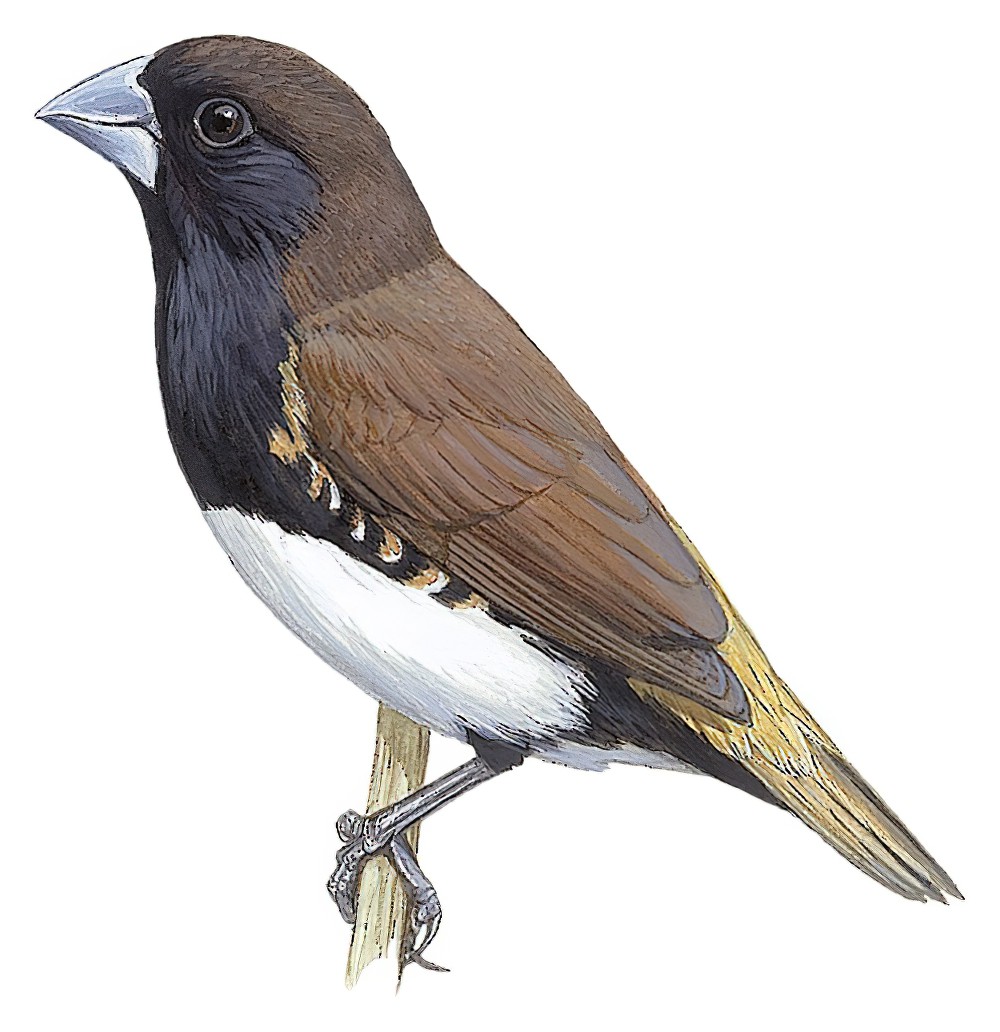Black-breasted Munia / Lonchura teerinki

Black-breasted Munia
SCI Name:
Protonym: Lonchura teerinki Am.Mus.Novit. no.1072 p.14
Taxonomy: Passeriformes / Estrildidae / Lonchura
Taxonomy Code: blbmun1
Type Locality: Bele River, 2,200 m., 18 km. north of Lake Habbema.
Author: Rand
Publish Year: 1940
IUCN Status: Least Concern
DEFINITIONS
LONCHURA
(Estrildidae; Ϯ Scaly-breasted Munia L. punctulata) Gr. λογχη lonkhē spear-head, lance; ουρα oura tail; "Genus LONCHURA. Rostrum forte, breve, latum, altitudine ad basin longitudinem æquans; mandibulis integris, superiori in frontem angulariter extendente cumque eo circuli arcum formante. Alæ mediocres, subacuminatæ; remigibus, 1ma brevissima subspuria, 2da 3tia 4taque fere æqualibus longissimis. Cauda gradata, lanceolata; rectricibus mediis cæteras paullo longitudine superantibus. Pedes mediocres, subgraciles. The peculiar spear-head form of the tail, and the ridge of the upper mandible and the forehead, forming a segment of the same circle, together with the habits of the following species, afford sufficient characteristics to justify their separation from the genus Fringilla of M. Temminck. The Gros-bec longicone of the Pl. Col. 96. (Emb. quadricolor, Lath.) belongs to the same group. 109. Lonchura nisoria. Fringilla nisoria, Temm. Gros-bec épervin. Pl. Col. 500. Fig. 2. ... 110. LONCHURA CHEET. ... 111. Lonchura leuconota. Fringilla leuconota, Temm. Gros-bec leuconote, Pl. Col. 500, fig. 1." (Sykes 1832); "Lonchura Sykes, 1832, Proc. Zool. Soc. London, p. 94. Type, by original designation, Fringilla nisoria Temminck = Loxia punctulata Linnaeus. Not preoccupied by Lonchurus Bloch, 1793 (Pisces)." (Paynter in Peters 1968, XIV, 372 (erroneous typification)); "LONCHURA Sykes, 1832 F - Fringilla nisoria Sykes, 1832; type by subsequent designation (Sharpe, 1890, Cat. Birds Brit. Mus., 13, p. 326). = Loxia punctulata Linnaeus, 1758" (Dickinson & Christidis (eds.) 2014, 297).
Synon. Dermophrys, Diacmura, Donacola, Maia, Mayrimunia, Munia, Oryzivora, Oryzornis, Oxycerca, Padda, Trichogrammoptila, Uroloncha, Weebongia.
teerinki
Maj. Carel Gerrit Jan Teerink (1897-1942) Dutch Army in the East Indies (Lonchura).
SUBSPECIES
Black-breasted Munia (mariae)
SCI Name: Lonchura teerinki mariae
mariae
• Female eponym; dedicatee not yet identified; "LE C. DE MARIE. T. MARIÆ. ... Patrie: Vénézuela." (Bourcier & Mulsant, 1846, Ann. Sci. Phys. Nat. Agric. Ind. Lyon, IX, p. 319); the possibilities are legion: Mulsant's mother was Marie Anne Victoire Mulsant née Jacquetton (1777-1854), his five daughters included Marie Rosalie Mulsant (1817-1841), Pauline Marie Mulsant (b. 1829), Marie Joséphine Caroline Mulsant (1833-1841), and Marie Jules Victorine Mulsant (b. 1842), his favourite grand-daughter was Marie Françoise Victoire Deduit (fl. 1846) who accompanied her grandfather on trips, his aunt was Marie Rosalie Etiennette Tuffet née Mulsant (d. 1834), and then we have Maria Sybilla Merian (1647-1717) Swiss-German botanical artist and entomologist in Surinam 1699-1701, and Marie-Rose Wachanru née Gaudemard (1821-1853) French entomologist, both of whom Mulsant admired (see julie) (syn. Amazilia beryllina).
• Marie Duclos (fl. 1850) mother of French zoologist Jean-Paul Coinde (syn. Bombycilla cedrorum).
• Margit Mária von Madarász née Ligeti (1862-1951) wife of Hungarian ornithologist Gyula von Madarász (subsp. Bradypterus lopezi).
• Mary Alexander (1843-1905) mother of explorer Capt. Boyd Alexander (syn. Calonectris edwardsii, subsp. Urolais epichlorus).
• Maria Madre I., Tres Marias Is., Mexico (subsp. Cardinalis cardinalis).
• Florence Mary Benson née Lanham (1909-1993) South African botanist, artist, wife of English ornithologist Constantine Benson (Björn Bergenholtz and Laurent Raty in litt.) (syn. Cisticola njombe, Nesillas, subsp. Zoonavena grandidieri).
• Mary Jane Hargitt (1832-1907) sister of Scottish ornithologist Edward Hargitt (cf. his mother Mary Hargitt née Bagley (1811-1853)) (Paul Scofield in litt.) (syn. Colaptes melanochloros).
• Mary Ella Terry née McLennan (1888-1967) wife of US geologist Robert A. Terry (subsp. Colinus cristatus).
• Marie-Izabel Ottonia von Jenisch Baronin von Plessen (1906-1971) wife of German ornithologist Victor Baron von Plessen (syn. Dicaeum maugei neglectum).
• Dr Stella Marie Aglaé Leche Deignan (1901-1993) US anthropologist, wife of ornithologist H. G. Deignan (subsp. Kurochkinegramma hypogrammicum).
• Lady Mary Jane Macgregor née Cocks (1863-1919) wife of colonial governor and explorer Sir William Macgregor (syn. Loria loriae).
• Female eponym; dedicatee not yet identified (Dementiev, 1932, Alauda, 4, p. 7) (OD per Björn Bergenholtz); perhaps after a relative of the Russian ornithologists Georgiy P. Dementiev or Sergei A. Buturlin, or the collector Brzesinski (syn. Loxia curvirostra guillemardi).
• Édouard Auguste Marie (1835-1889) French commissariat civil servant in New Caledonia 1869, conchologist, collector (Megalurulus).
• Elizabeth Mary La Touche (1907-1973) daughter of Irish ornithologist J. D. Digues La Touche (subsp. Minla ignotincta).
• Mary Moncrieffe Ripley née Livingston (1914-1996) US amateur botanist, entomologist, wife of ornithologist Dr Sidney Dillon Ripley II (subsp. Leptocoma aspasia, subsp. Lonchura teerinki, subsp. Pericrocotus ethologus, syn. Phylloscopus fuscatus).
• Mary Alice Ramsay née Hogg (d. 1951) wife of ornithologist Col. R. G. W. Ramsay (syn. Pomatorhinus ferruginosus albogularis).
• Grand Duchess Maria Nikolayevna (1819-1876) eldest daughter of Tzar Nicholas I of Russia and wife of Maximilian de Beauharnais Prince of Eichstädt and 3rd Duke of Leuchtenburg (subsp. Pteroglossus azara).
• Marie Jacquinot (born Sylvie Eugénie Pinot or Pinault or Pinaud) (1794-1857) mother of French surgeon-naturalist Honoré Jacquinot (subsp. Ptilinopus perousii).
• Mary Elizabeth Baker née Waddell (1913-2000) wife of US zoologist and biogeographer Lt. Rollin Harold Baker (subsp. Rhipidura rufifrons).
Black-breasted Munia (teerinki)
SCI Name: Lonchura teerinki teerinki
teerinki
Maj. Carel Gerrit Jan Teerink (1897-1942) Dutch Army in the East Indies (Lonchura).
UPPERCASE: current genus
Uppercase first letter: generic synonym
● and ● See: generic homonyms
lowercase: species and subspecies
●: early names, variants, mispellings
‡: extinct
†: type species
Gr.: ancient Greek
L.: Latin
<: derived from
syn: synonym of
/: separates historical and modern geographic names
ex: based on
TL: type locality
OD: original diagnosis (genus) or original description (species)












